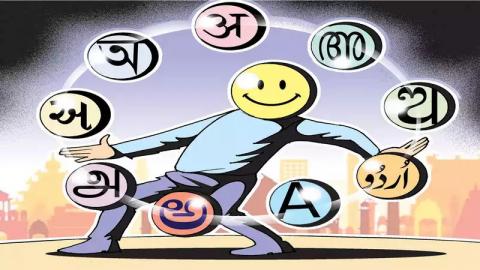
India doesn’t need a national language. Plus, Hindi is growing & English is no longer elitist.
Every now and then someone notices that India doesn’t have a national language and the old controversy resurfaces. This time Ajay Devgn, the Bollywood star of the movie Singham, noticed, and he asserted that “Hindi was, is and always will be our mother tongue and national language.” The UP Minister, a BJP ally, Sanjay Nishad, went further, “Hindustan is not a place for those who don’t speak Hindi. They should leave this country and go somewhere else.” Go where? Where should 78 crore non-Hindi speakers go? In theory, a national language is nice idea, but imposing it in a multi-lingual country can be disastrous.
Look at the experience of two nations. When Pakistan was born, Jinnah declared spiritedly that Urdu would be the national language. At the time, the mother tongue of 55% of Pakistanis was Bangla; only 7% understood Urdu. Resentment soon built up among the proud Bengalis, and this led to a movement for secession. To stop East Pakistan from seceding, Pakistani generals unleashed genocide, killing lakhs of their own people in 1971, and sending millions of refugees into India. As a result, Pakistan broke up and a new state of Bangladesh was born.
Similarly in Sri Lanka, Bandaranaike implemented in the 1950s ‘Sinhala Only Act’, disenfranchising the Tamil minority. The language decision resulted in riots, and it led to a 25-year long civil war between the Tamil minority and the Sinhalese majority. Once a model nation of South Asia, Sri Lanka was brought to its knees.
Jinnah’s decision led to the breakup of Pakistan and Bandaranaike’s to a civil war that lost a generation in Sri Lanka. These are cautionary tales of imposing linguistic nationalism.
India has been lucky. It may have made many mistakes but imposing a national language is not one of them. Hindi nationalists tried time and again, to impose Hindi. The most serious threat came in the 1960s but Lal Bahadur Shastri’s government backed off wisely when Tamils threatened to secede. In the past 75 years, India has managed quite well without a national language. So has Switzerland, another multilingual nation without a national language. It has one of the highest per capita incomes in the world and ranks high on the Happiness Index. A successful nation doesn’t necessarily need a national language.
A ‘national language’ is a false 19th century ideal of European nationalism. This nationalism brought about two world wars in the 20th century, killing an estimated 60-80 million people. Sickened by the evil deeds of nationalists, especially the Nazis, the world turned its back on nationalism, national language, and national religion. But in India, the desire for a Hindi Rashtra also reflects a deep-seated resentment of English as the language of the elite that has ruled for the past 75 years. English is not just a language in India, it is a caste. It is one of the reasons why Home Minister Amit Shah said on April 7th, “Indian people of different states should communicate with each other in Hindi, not in English, in a language of India."
But the honourable minister, Ajay Devgn, and Sanjay Nishad need to relax. In the past 75 years, India has changed in three profound ways. One, English has quietly become an Indian language, just as cricket had become an Indian game. Both happen to have been invented in England. Whoever speaks a language owns it, just as whoever plays the game possesses it. English is now the most widely spoken language in India after Hindi with 130 million speakers in the 2011 census. Based on trends, India will cross the United States one day in having the largest numbers of English speakers in the world.
The second change is that Hindi is the fastest growing language in India, spreading rapidly thanks to Bollywood. If English is our language of opportunity, Hindi is our language of entertainment. A third change is the rise of a confident hybrid, popular among young, decolonized minds. My newspaper boy assures me, ‘Aaj busy hoon, kal bill milega, definitely’. Youngsters in Chennai comfortably mix English with Tamil as easily as they mix Tamil with English. Advertising slogans claim, ‘Life ho to aise’ and ‘Dil mange more’. Zee News’ bulletin claims, ‘Aaj Middle East mein peace ho gai,’ a mixture of three English and four Hindi words. Linguistic purists disapprove of this slang but it breathes easy under the hot Indian sun, flowing loosely like a kurta or a saree, not buttoned up in a suit and tie. It has the makings of Indian English language may one day aspire to become a national language.
India’s language policy should focus on the future, not on the past. It should help create opportunities for the young, not try and satisfy old politicians. The New Education Policy is basically correct. It is a good idea for children to begin learning in their mother tongue. However, kids should simultaneously learn English from KG onwards. Every mother in the world knows that English is the global language of opportunity. It is why India’s government schools are emptying, and why more than half of India’s children attend non-elite private schools. Children are naturally multilingual and pick up languages easily. Technology now allows English and Hindi to be taught joyfully through Apps, as though one is playing a game, making it easy, cheap, and fun while removing the class divide.
So, why try and force Hindi down the throats of non-Hindi speaking people when it is already the fastest growing Indian language? Hindi, English, Hinglish are spreading on their own. If India has managed without a national language, why fix something that isn’t broken? Why risk the break-up of our country or a civil war? If we do not learn from the mistakes of the past, we shall surely repeat them.